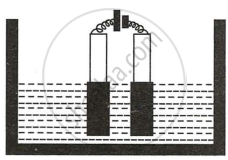Advertisements
Advertisements
प्रश्न
A solution contains magnesium ions (Mg+2), iron (II) ions (Fe+2) and copper ions (Cu+2). On passing an electric current through this solution, which ions will be the first to be discharged at the cathode? Write the equation for the cathode reaction.
उत्तर
Cu+2 will be discharged first.
\[\ce{Cu^{+2} + 2e- -> Cu}\]
APPEARS IN
संबंधित प्रश्न
Substances which conduct electricity in the solid state are generally ______.
Correct the sentence by adding word(s)
The electrolysis of lead bromide liberates lead and bromine.
What kind of particles will be found in a liquid compound which is a non- electrolyte?
Explain how electrolysis is an example of Redox reaction.
Why is carbon tetrachloride, which is a liquid, a non-electrolyte?
Three different electrolytic cells, A, B and C are connected in separate circuits. Electrolytic cell A contains a sodium chloride solution. When the circuit is completed, a bulb in the circuit glows brightly. Electrolytic cell B contains an acetic acid solution and in this case, the bulb in the circuit glows dimly. The electrolytic cell C contains a sugar solution and the bulb does not glow. Give a reason for each of these observations.
Copper sulphate solution is electrolyzed using copper electrodes. Study the diagram given alongside and answer the questions that follow.

- Which electrode to your left or right is known as the oxidizing electrode and why?
- Write the equation representing the reaction that occurs.
- State two appropriate observations for the above electrolysis reactions.
Give reasons why sodium chloride will conduct electricity only in the fused or aqueous solution state.
State the observation at the anode and at the cathode during the electrolysis of :
Fused lead bromide using graphite electrodes
Classify the following substance:
Dilute sulphuric acid
